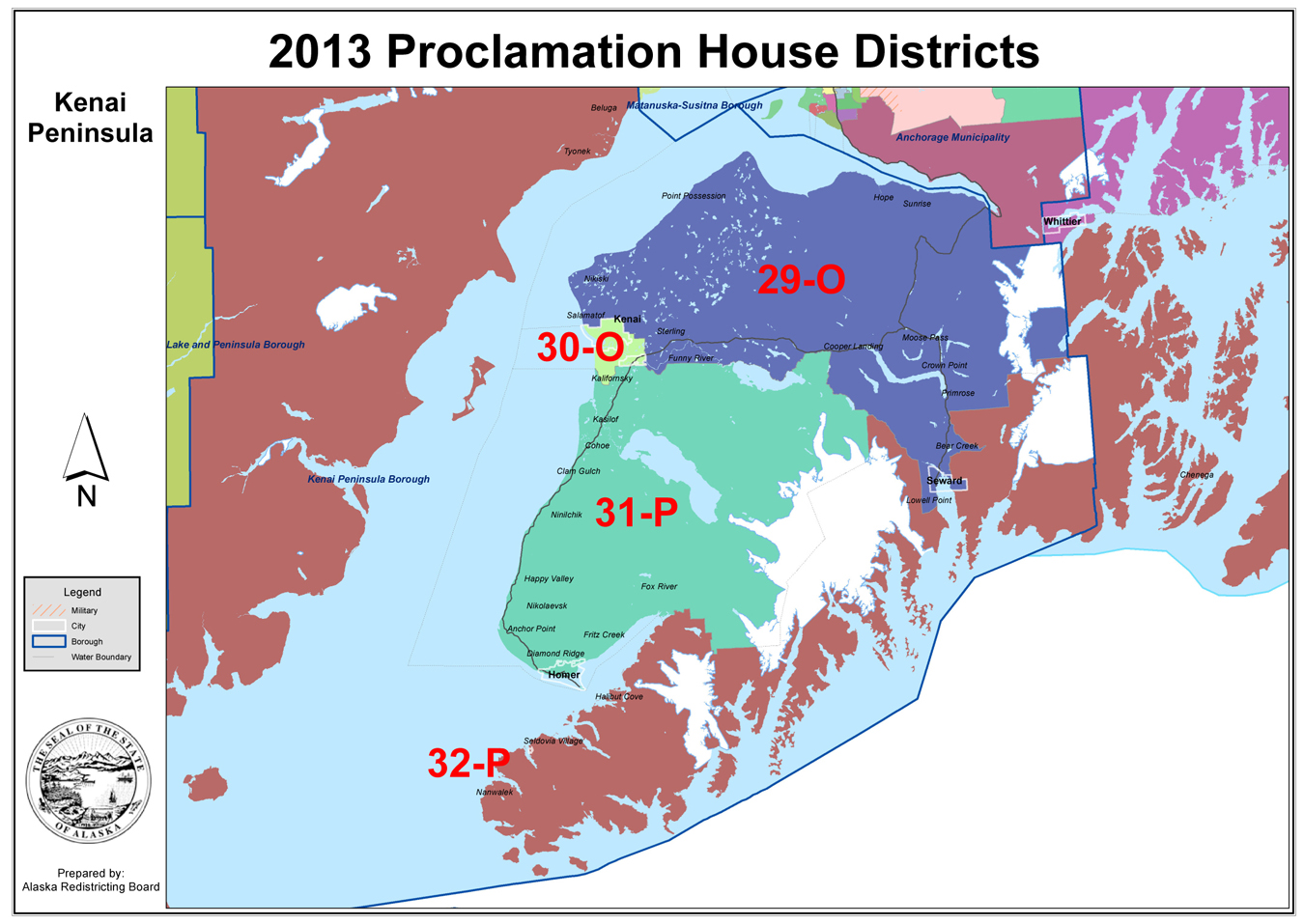Homer will go forward into the past with a redistricting plan passed last month by the Alaska Redistricting Board. Following an Alaska Supreme Court decision that the board redo the 2012 plan, the board last month approved new House and Senate districts and, if it wins court approval, will include these changes:
• The lower Kenai Peninsula will be put into Senate District P, a district that includes a House district of Kodiak Island. If re-elected in the 2014 elections, Sen. Gary Stevens, R-Kodiak, would again represent Homer, as he had until 2012.
• Senate District O, the district now represented by Sen. Peter Micciche, R-Soldotna, will no longer include Homer, and will include the north peninsula, including Nikiski. Nikiski had been in a Senate district that included south Anchorage, but now goes back into a Kenai Peninsula Senate district.
• The south shore of Kachemak Bay, including Seldovia and Halibut Cove, will be moved into House District 32. If Rep. Paul Seaton, R-Homer, is re-elected in 2014, he will no longer represent that area. That new district, to be called District 31, will include the north shore of the bay and keep in one district all the Russian Old Believer communities of Kachemak Selo, Nikolaevsk, Razdolna and Voznesenka, and the lower peninsula north to Funny River and Kalifornsky.
• Nanwalek and Port Graham, previously in a House district that included the west side of Cook Inlet, would be in House District 32 as well.
“We’re in the same situation of the Senate reverting back to where it was from 2003 to 2012,” Seaton said. “I hate losing the folks in Seldovia, Halibut Cove on the south side of the bay. We in the Legislature don’t get to determine who we represent. The districts are drawn and it’s ‘Do you want to run in that district?’”
The 2013 Proclamation Plan, as the redistrict board calls it, still must pass court approval. On July 18 the board filed a motion for final judgment in Fairbanks Superior Court. On July 25, George Riley and Ron Dearborn, two Fairbanks area plaintiffs who had successfully challenged the 2012 redistricting, filed another suit seeking corrections to the latest plan. They assert that the plan in some areas fails to follow the so-called Hickel process, a reference to a 1992 Alaska Supreme Court decision which says that districts formed shall follow the Alaska Constitution and be formed of contiguous and compact territories containing a relatively integrated socio-economic area. The House Districts also shall be equal in population by dividing the 2010 Alaska census by 40, the number of districts. That number is about 17,750 residents per district.
Seaton said that as he understands the redistricting process, the courts have determined that the boundaries of a borough are a socio-economic unit. The Kenai Peninsula has enough population to make up three House districts. Under the new plan, those would be House Districts 29 and 30, which are included in Senate District 0, and House District 31, the lower peninsula, which would be included in Senate District P. Any excess population in a borough, such as the south shore Kachemak Bay villages, can go to a district outside the borough, Seaton said, but a borough’s excess population can only go to one such district.
A draft plan for the 2012 redistricting also had separated Kachemak Bay communities. Seaton said he testified against that plan then.
“My feeling was that within the local communities is pretty much a socio-economic unit and it should be held together if at all possible. That didn’t fly,” he said in reference to the board once again separating the bay.
Micciche said doesn’t like the change in Senate districts.
“I’m disappointed to lose one of the most beautiful parts of the state,” he said, referring to Homer.
The freshman senator, who defeated former Sen. Tom Wagoner in the 2012 Republican Party primary and ran unopposed in the general election, said he also appreciates Homer’s liberal to moderate constituency.
“One of the most important aspects of the south peninsula that’s been good to me is the diversified aspect of the district,” Micciche said.
The new districts, if approved by the courts, won’t take effect until the 2014 election. Micciche and Seaton will still represent their current areas until then. Even after 2014, and if he’s re-elected, Micciche said he would still work with the House Districts 31 and 32 representatives and the Senate District P senator on Kenai Peninsula issues. Micciche would represent House District 30, the Kenai-Soldotna area, and District 29, Nikiski, Sterling, Cooper Landing and Seward.
“As far as I’m concerned, I’ll be representing the region,” he said.
Seaton said if he’s re-elected he also would work with the District O senator as well — Micciche, if he’s re-elected.
“I really enjoyed working with Peter. We get along well,” he said. “But I work well with Gary (Stevens), too. We have some close philosophies.”
Micciche said no matter what, constituents have praised his service.
“Whatever the district will be, the ultimate compliment I’ve received was, ‘I may and, or may not agree with a decision of yours, but I’ve seen more of you than other senators,’” Micciche said.
Michael Armstrong can be reached at michael.armstrong@homernews.com.


